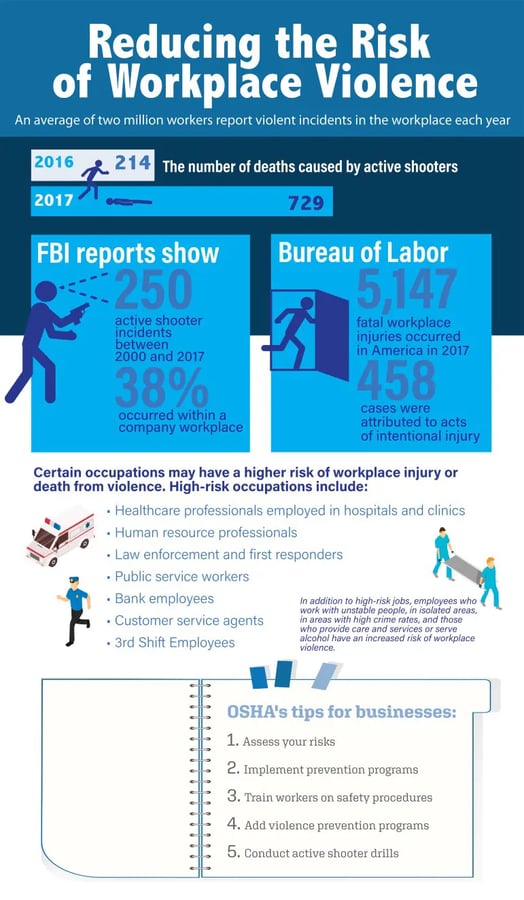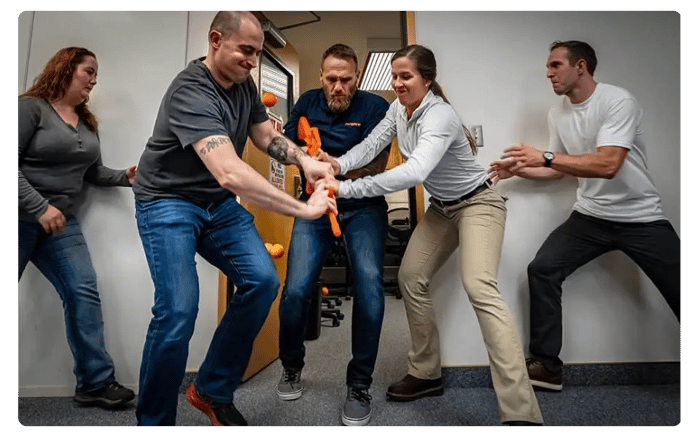Reflecting back to September of 2017, over the span of 24 hours the people of Maryland suffered three unrelated violent workplace events at a software company, a municipal building and a distribution center. Lives were lost, and businesses were disrupted in profound ways. This story horrifying, but unfortunately not uncommon. Many companies, perhaps yours included, have workplace violence plans in place – but is something your practicing regularly?
If you have a plan, no matter what industry you are in, chances are it’s not enough. Read on to find out what you might be missing and learn how to confidently protect your employees and customers. Is it worth your time to analyze your plan and make adjustments? Because lives could be at stake, we suggest it is.
Best Practices: Workplace Violence Plans
Effective workplace violence plans consist of three phases: policy, plan and practice. As incidents have risen and become prevalent in mainstream media, many companies have added workplace violence to their Human Resources department protocols or Operations duties. Policies have been established and formal plans have been written.
However, based on Prime Secured’s experience with numerous safety and loss prevention scenarios, the plans often sit on a shelf or in a computer folder and gather dust. “If training is completed, it’s often just one cursory session on workplace violence to communicate policies to managers and/or employees,” said Brian Freeman, Prime Secured’s VP of Enterprise Sales. “If technology is added or protocols put into place, it’s often the bare minimum. That is where many plans stop, and that’s the deadly missing link.”
Unlike some workplace policies, workplace violence procedures must be practiced fairly frequently to be effective when it matters most – not just reviewed verbally. Companies seem to be reluctant to put employees through the twice-yearly drills or make technology changes necessary for effective mitigation of incidents.
Further, many companies are reluctant to do the legwork required for effective prevention of workplace violence – to stop incidents before they even start. “It’s human nature to believe violent events won’t happen to us in our own workplace,” Freeman explained, “But the instant an event begins to unfold, any lack of preparation will be painfully obvious. We know this, but we tend to avoid even thinking about what scares us.”
Whatever the reasons for not following through, some companies are putting policies and plans in place simply to say they are doing it, and then congratulating themselves on being progressive. In some cases, uncertainty about what to do to prepare for violence causes paralysis – but doing nothing IS doing something. It’s leaving your workplace and the precious people within it vulnerable.
Our Blog
Subscribe to the Prime Secured blog to receive the latest updates.
What is Workplace Violence?
The definition of workplace violence according to OSHA (U.S. Department of Labor) is: “Any act or threat of physical violence, harassment, intimidation, or other threatening disruptive behavior that occurs at the work site.” It ranges from threats and verbal abuse to physical assaults and homicide. It can involve employees, clients, customers and visitors. OSHA says workplace violence is currently the fourth leading cause of fatal occupational injuries in the United States.
The rise in violent deaths in the workplace in the U.S. is noticeable. The latest official numbers show a 11% increase from 2016 to 2019. In 2020, assaults resulted in 20,050 injuries and 392 fatalities. Some professions see an even higher increase in workplace violence. Taxi drivers, for example, are 20 times more likely than other employees to be murdered on the job. Injury Facts, the annual chartbook of the National Safety Council, lists figures for different industries; government offices and education and healthcare facilities are at the top of the list.
On average, more than 2 million American workers report having been victims of violence at work, and that’s not including unreported incidents.
Workplace violence can be inspired by events on television or in social media, domestic disturbances, and stresses at work or elsewhere. People may desire their “15 minutes of fame”, even if it leads to their imprisonment or death. “Or they may feel no one is listening to them and believe a violent act is the only way to make their voices heard,” Freeman said.
OSHA identifies four types of workplace violence, each with different considerations.
- Employee vs. Criminal Outsider
This category and the category Employee vs. Significant Other account for the most violence and deaths in places of work. This type of violence is most likely to take place where there is contact with the public, or where cash or high-priced items are kept. Solutions to prevent and manage violence in this type of environment include electronic and physical access control, techniques for safely handling cash, electronic systems, and video surveillance.
- Employee vs. Client
In locations where large numbers of clients are present at the same time, or where emotions and stress are prevalent, violence may occur between employees and customers. This tends to happen in places such as medical facilities and educational campuses. Solutions include weapons detection, CCTV monitoring, and access control in non-public areas.
- Employee vs. Employee
Some sources say this is the type of workplace violence that get the most press – for example, when a disgruntled employee opens fire on his or her fellow employees. Stressful situations at work can precipitate violence, especially when many employees work near one another. Prevention includes access control and monitoring, as well as watching for stresses such as terminations, layoffs and other disciplinary processes.
- Employee vs. Significant Other
Although gender doesn’t necessarily predict workplace violence perpetrated by significant others, this type of violence is by far more of a concern for female workers. As such, it is more likely to happen in workplace environments where there is a large number of females. Prevention includes watching for signs of stress or fear, creating an environment of trust where workers are comfortable asking for help, and limiting access by non workers.
No matter where or why the violence happens, once an incident begins, many of the considerations are the same for all types of violence. The outcome depends on whether personnel and employees are trained and thoroughly practiced in conflict resolution, incident management, law enforcement contact, and survival skills.
 Photo credit Ankin Law
Photo credit Ankin Law
Why Employers Need to Pay Attention to Workplace Violence and Find Solutions
According to the FBI, “Employers have a legal and ethical obligation to promote a work environment free from threats and violence.” But workplace safety goes far beyond legal and ethical obligations. It is likely to affect the bottom line.
The Society of Human Resources Management suggests there are many economic costs employers face as a result of workplace violence. The top three are (1) management time and expenses, (2) productivity loss, and (3) staff replacement due to turnover. If employees don’t feel safe, their work tends to suffer, absenteeism increases, and they may quit.
Costs can explode if a company is found to be legally liable for negligence. You can be sued for lack of preparation, or even negligence in hiring and retention policies if an employee commits an act of violence. If workers get hurt, you may face workers’ compensation claims.
For all these reasons, it is critical that your company periodically examine its workplace violence policies and plans. Most importantly, it is essential that you add a robust practice schedule, complete with situation analysis training and role playing.
Tips for Managing the 3 Phases of Proactive Workplace Violence Programs
Some methods of handling workplace violence have been around as long as humans have disagreed with one another. These methods include principles of conflict resolution and physical barriers in general. However, as technology has advanced, the tools available for addressing and preventing violence have expanded.
Below, we list basic tenets and tips related to each of the three phases of an effective workplace violence: policy, plan and practice. As you read, think about your own organization. What do you have in place now? How well do you believe you would do in a real-life violent situation? Where do you need to fill the gaps?
Step 1: Establish a Custom Workplace Violence Policy
Begin with conversations about policies. You may want to create a task force or committee to analyze your place of business’ unique needs and create a policy document or add policies to your employee handbook, then communicate them thoroughly to all personnel.
Your formal policies should include considerations related to:
Training. Work backwards from a fictional incident. Who will you look to for leadership and specific actions? Set up training sessions and materials to prepare all personnel – see section on practice below.
Potential liability. No matter what policies are put in place, ensure your organization is following laws and best practices to optimize your legal position in the event of violence. Mention specific potential behaviors in your policies to support your legal right to discipline employees.
Risk identification. Background checks (where allowed) and social media monitoring can help identify those who may show signs of potential violence or who could become victims. Understand what you can and can’t do, so that you not only avoid legal issues but preserve the dignity and rights of employees and others.
Zero tolerance. It’s important to state that you have a zero tolerance rule as well as what that means in terms of consequences. Include a formal weapons ban where allowed by law.
Technology. Official workplace violence policies should mention tools you may have in place to help monitor workers and others, limit access, record incidents and other considerations. Include regular maintenance to ensure reliability.
Hiring and firing. In addition to following the law, write in procedures that show respect and concern for employees and others to document your care. Always be consistent in the way you treat employees to avoid perceived discrimination.
Step 2: Create a Workplace Violence Plan
Identify where you have potential problems in your place of business. OSHA believes that a well-written and well-implemented plan, “combined with engineering controls, administrative controls and training can reduce the incidence of workplace violence in both the private sector and federal workplaces.” Write down the plan and make sure it’s on file – but, more importantly, make sure all personnel know it well. See practice section below.
Areas of your organization to asses:
Prevention. Above all, think carefully about protocols that could help you prevent violent incidents in the first place. Establish employee assistance programs, take every potential threat seriously, educate staff on conflict resolution, know your employee base and potential violence common to them, give managers authority to assess situations and take action. One of the most powerful prevention actions you can take is to build a culture of respect, caring and trust. Another is reducing stress in the workplace.
Access control. Do you have tools in place to screen employees and visitors coming into your location? Where are your entrances and how is each of them protected? Can you deactivate badges easily? It’s not only important to verify their right to be on premises, but to ensure they are not carrying a weapon.
Video surveillance. Where are your points of greatest risk both inside and outside of your buildings? (Work with professional security technicians to help identify these based on industry best practices and experience with other organizations.) Will cameras allow communication at the site to deter violent behavior? Do cameras reach far enough into areas of risk? Are images clear enough – and will streaming cause other issues, such as slowing digital transactions?
Redundancy. Do you need several layers of control, such as badges, turnstiles and metal detectors? If loss control is an issue, how can security tools double as loss prevention tools?
Law enforcement. Ask for help assessing security from local law enforcement professionals. In the event of a violent incident, their knowledge of your policies and plan could save time and lives.
Know the signs. Make sure your plan includes education of staff on common signs preceding workplace violence incidents. Some of the most common are: depression, withdrawal, suicidal comments, mood swings, paranoid behavior, talking about or bragging about violence, excessive use of alcohol or drugs, unexplained absenteeism, resistance to change, and violation of company rules.
Communication. Once your policies and plan are on paper, make it real by communicating thoroughly and regularly with all personnel, as well as frequent visitors to your locations – and law enforcement and emergency services.
The key to creating a truly effective workplace violence plan is asking “What if?” then putting tools, procedures and well-trained and practiced personnel in place – and updating your plan regularly to make it a living, breathing document, not just a report that sits on a shelf.
 Employees practicing active shooter training. Photo credit: HSI
Employees practicing active shooter training. Photo credit: HSI
Step 3: Practice Workplace Violence Scenarios
“This is where most organizations fail,” Freeman revealed. Policies and planning can only go so far when a violent workplace incident happens. People involved are likely to panic and any knowledge they have from reading an employee handbook or workplace violence plan and policies can easily be forgotten. The only way to imprint lifesaving actions into the minds and muscle memory of your employees is to practice skills regularly. Freeman said Prime Secured suggests conducting drills and role-play exercises at least twice a year.
Workplace violence drills should include:
Technology testing. Make sure electronic and digital access control equipment and video surveillance monitors are working properly. Practice using them in a role-playing drill to help personnel identify gaps and nurture quick response.
Varied scenarios. Practice several different types of workplace violence situations and events, such as employee fistfights, disgruntled former employees entering with intent to harm, bomb threats, and domestic violence. Lead employees in role-played scenarios.
Training materials. Make use of videos and other free materials available in your state, through your industry organizations, or from the U.S. Department of Labor and OSHA. If your operation is extensive, consider producing your own videos to help employees learn your protocols. Note: Avoid showing aspects of your system that would allow perpetrators to “beat the system.”
De-escalation. The goal always should be to first reduce the intensity of the violence if possible with techniques such as conflict resolution, distraction, and listening. It’s also important to warn other employees, clear the area, and contact law enforcement.
Survival. Employees should practice survival skills, beginning with identifying the risk and choosing an appropriate survival action ranging from escaping as soon as possible and protecting others to fighting back when physical danger is imminent.
Don’t forget that communication is probably the most important element of your entire workplace violence plan. Your people must understand not only what is expected of them in the event of violence but feel confident you are making them as safe as possible while they work.
Next Steps: Get a Professional Workplace Violence Assessment
This article describes the basics of any effective workplace violence program for any organization – it serves as a refresher if you already have a system in place or a basic blueprint if you’re building a program from scratch. However, no matter what stage of development you’re in, you can sometimes get too close to the plan to clearly and honestly assess potential issues. “A professional workplace violence security provider can help you not only identify opportunities for increasing effectiveness of your plan but help determine which tools are the best for your unique layout and workforce,” Freeman said.
Active Risk Survival is a risk assessment provider we recommend. When it comes to looking at the gaps in your technology that’s where our experts at Prime Secured come into play.
Call 402.289.4126 any time to discuss workplace violence best practices and figure out your next steps. Will your team be ready if the worst happens?
Leave Your Comments Below:

